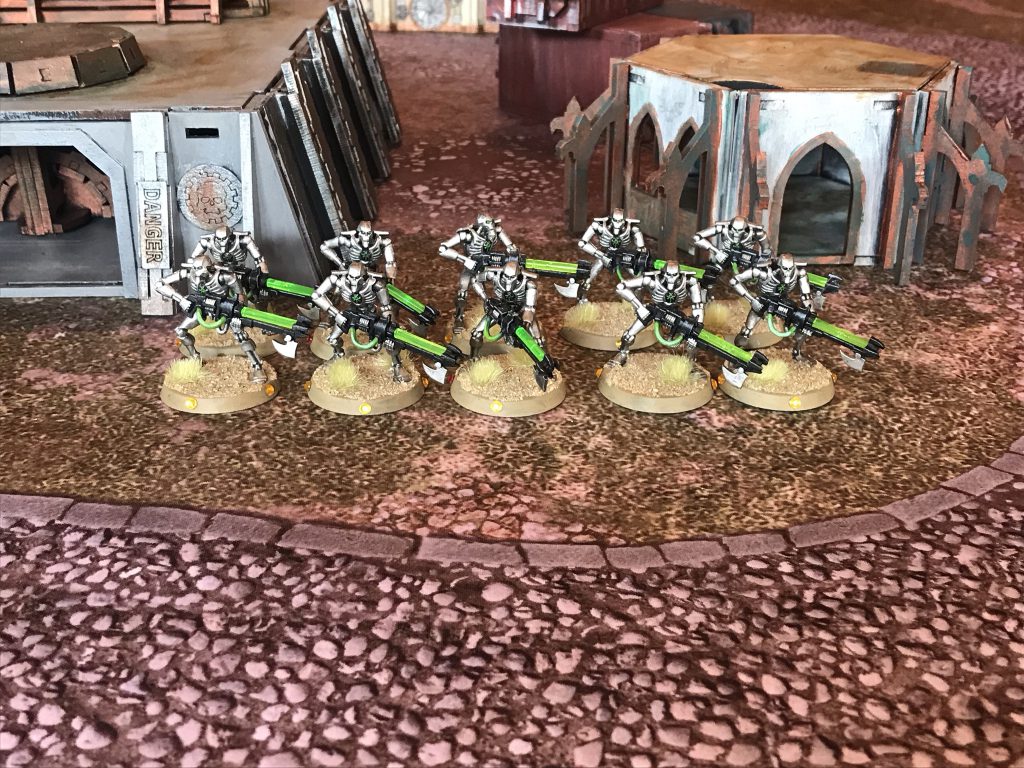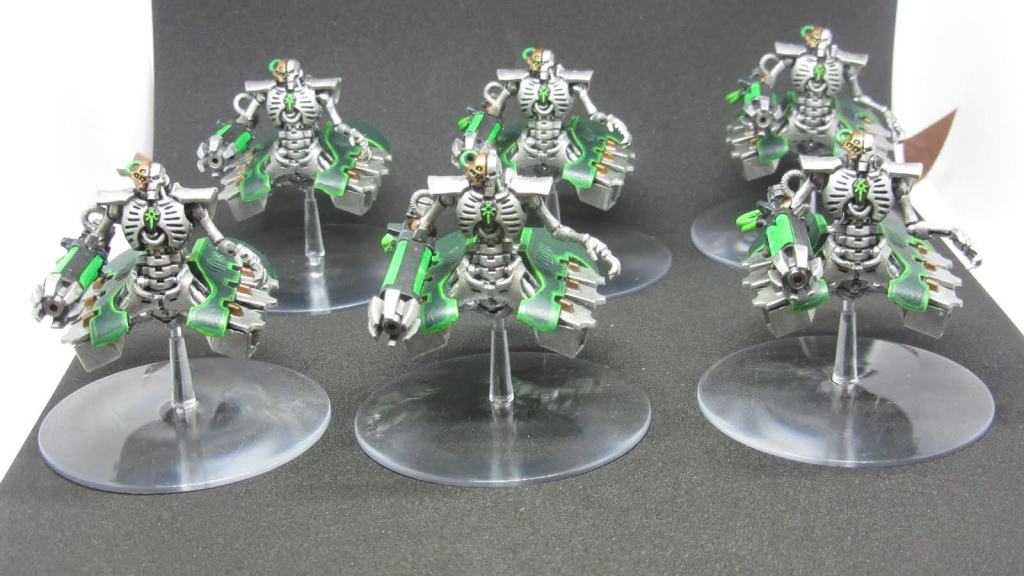This week’s Hammer of Math takes us back to the Necrons and the mechanics surrounding their core Reanimation Protocols ability. With Psychic Awakening right around the corner we here at Goonhammer are excited to see how this wonderfully flavorful but sadly underpowered faction fares with new rules and Stratagems.

Necrons have some really fun, flavorful rules that coincide well with their status as ancient robotic murder machines and one of their defining powers is Reanimation Protocols (RP). The rules behind this ability are fairly straightforward; at the beginning of a turn a player rolls a D6 for every slain model in a unit. On a 5+ the model is returned to the unit with its full complement of wounds, otherwise it remains inactive and you can roll again. The model must be set up within unit coherency with another model that hadn’t returned to the unit this turn and more than 1″ away from enemy models. This is a really fun core ability that represents the inexorable terror of units you just destroyed standing up as if nothing had happened. In theory this is a superior version of Feel No Pain, only it works from beyond the grave. Note that the unit must have an acceptable target to establish unit coherency; if the unit is completely destroyed then Reanimation Protocols won’t work. The rule also doesn’t work against casualties from morale. The rule can be found on most INFANTRY and BIKER units (Warriors, Immortals, Lychguard, Deathmarks, Flayed Ones, Triarch Praetorians, Tomb Blades, Destroyers) and can also be temporarily applied to units with the CANOPTEK keyword, of which only Wraiths, Scarabs, and Spyders can benefit from it via the Repair Subroutines Stratagem for 2 CP.
There are also a few ways to modify the roll:
- CRYPTEK units provide the Technomancer ability which adds +1 to the RP rolls for nearby units.
- LORD models use a Resurrection Orb which permits a <DYNASTY> INFANTRY unit within 3″ to make RP rolls, allowing multiple RP rolls to be stacked in one turn. The orb only works once per game. Note that there are no CANOPTEK units with the INFANTRY keyword which could benefit from this ability.
- The Orb of Eternity is a Relic which replaces a resurrection orb and, once per game, allows a friendly INFANTRY unit to add +1 to the RP rolls from that orb’s mechanic.
- The Enhanced Reanimation Protocols stratagem costs 2CP and allows you to re-roll RP rolls of 1 for that unit this turn.

Regarding the resurrection orb, we at the Goonhammer brain trust spent some time figuring out how exactly this works in terms of timing. For example could you chain orbs, seeing the results from one RP roll before applying another? We think the answer is this:
- The orb is triggered by the RP rolls occurring at the beginning of the turn.
- Once the orb is triggered, it’s no longer the beginning of the turn so you can’t chain the effect.
- You can trigger multiple orbs, but you have to declare them simultaneously.
- For every orb you trigger on the same unit, you can attempt a RP roll. You can’t return a model to a unit more than once.
- Effects like Technomancer and Enhanced Reanimation Protocols happen to every RP roll, but the bonus from Orb of Eternity only goes to that particular set of RP rolls.

The first thing we wanted to figure out was what was the probability that a model would come eventually come back given different modifiers and number of attempts. It doesn’t matter if the attempts come as a result of a resurrection orb or through time; the math is the same. The calculation is as follows:
P(Reanimation) = 1 – [1 – P(RP)]^N
Where P(RP) is the probability of a Reanimation Protocol success (33% normally or 50% with a +1 modifier), and N is the number of attempts. What we’re doing is calculating the probability that a roll will fail for N consecutive attempts, and then taking the inverse to determine the probability that there will be at least 1 success. The bonus from the Orb of Eternity will only ever apply once, but if you combine it and a Cryptek the result is a 66% chance of reanimation. Combine with a Cryptek and Enhanced Reanimation Protocols and the probability of reanimation is 78%. The remaining probabilities can be seen in the chart below.
| Modifiers | 1 Roll | 2 Rolls | 3 Rolls | 4 Rolls | 5 Rolls |
| None | 33% | 56% | 70% | 80% | 87% |
| +1 Modifier | 50% | 75% | 88% | 94% | 97% |
| Re-Roll 1s | 39% | 63% | 77% | 86% | 91% |
| +1 and Re-Roll 1s | 58% | 83% | 93% | 97% | 99% |
We can get a few takeaways from this chart. First, we see that the effect of Enhanced Reanimation Protocols is minimal; a roughly 6% to 8% improvement depending on the presence of a +1 modifier. 2 CP is an huge price to pay for such a minuscule effect for only a single model, especially when compared to army wide bonuses such as Prepared Positions which gives cover to the entire army for the same cost. Second, depending on the target unit the application of a resurrection orb can easily be worth the 18 points the upgrade costs. As one might expect the efficacy increases the more valuable or larger the number of models reanimated. To make your points back your goal should be to apply the orb to a unit with at least 79 points of models to reanimate. That’s around 8 Necron Warriors or a pair of Necron Destroyers. Third, the bonus from Crypteks is three times as effective as Enhanced Reanimation Protocols and has the benefit of not costing you any CP and applying to multiple units. The results also reveal the danger of leaving even a single model alive, particularly in the presence of a Cryptek. It may not be particularly difficult to kill 13 Warriors in a single turn, but if you only kill 12 from that unit most of them will be back in two turns.
Wrapping Up
Reanimation Protocols is one of the most interesting and unusual abilities among the factions of 40K, and hopefully the release of Pariah will provide Necrons with a much needed boost that allows this fun and interesting faction to be more effective and viable. From the math we can see that, given time or resurrection orbs, Necron units can rapidly come back together and pose a significant threat – the main issue with the rule isn’t its mathematical efficacy, it’s that destroying the unit completely denies the chance to roll, which means that an opponent focusing fire can cause it to vastly underperform against its potential. Kill them all, or they’ll be back.
As always, thanks for reading. If you have any feedback, feel free to drop a note in the comments below or email us at contact@goonhammer.com. If you have any questions that you would like answered, please submit them here.



You must be logged in to post a comment.